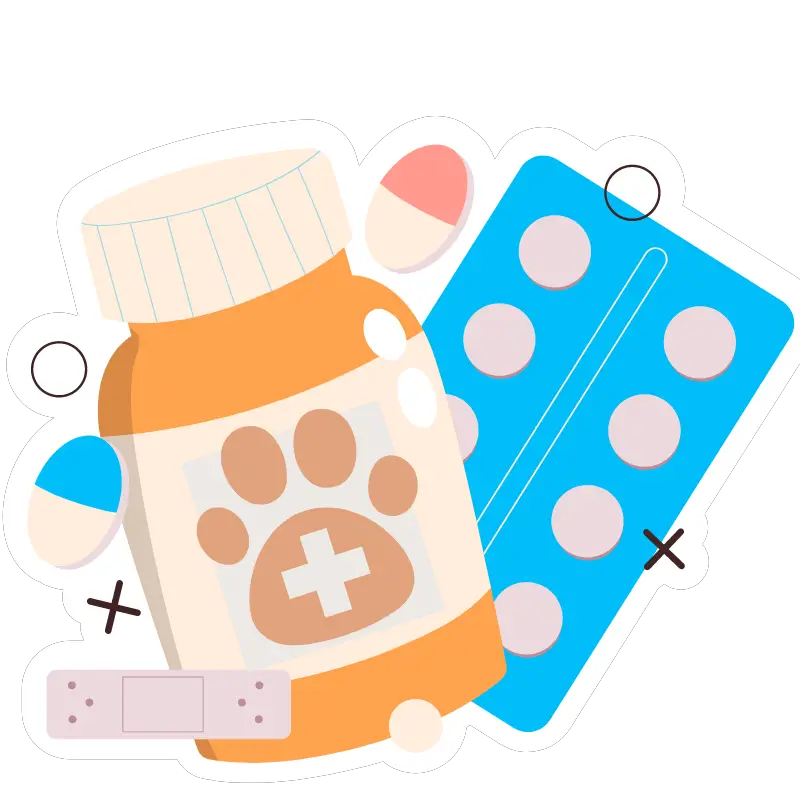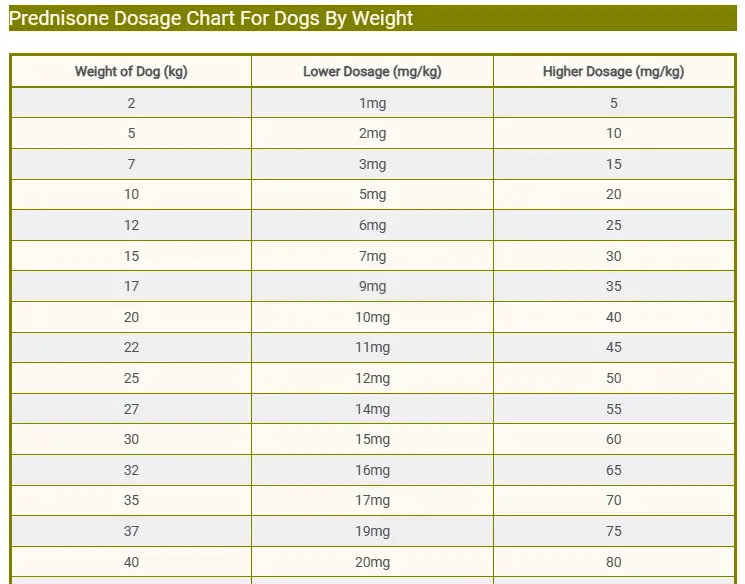The ideal dosage of prednisone for dogs to treat inflammation is typically 0.5 mg/kg to 2 mg/kg daily. However, the dosage for treating other health conditions can vary depending on your pet’s health condition and the severity of the illness.
Prednisone Dosage For Dogs

-
Ideal Dose: 0.5-2mg/kg (0.2-0.9mg/lb).
-
Uses: Treat inflammatory, autoimmune, and cancerous conditions in dogs.
-
FDA Approved: Yes.
-
Variants: Tablets.
-
Storage & Handling: Room Temperature.
-
Administration: Once Daily.
Disclaimer: Self-medication can be hazardous. Please consult your veterinarian for personalized guidance on the appropriate dosage for your furry friend’s specific condition.
When your furry companion is suffering from a medical condition like allergies, arthritis, or autoimmune disorders, finding the right treatment becomes a priority.
Prednisone, a corticosteroid medication, is commonly prescribed by veterinarians to alleviate inflammation and manage various ailments in dogs. However, determining the appropriate dosage of prednisone for your beloved pet can be a daunting task without proper guidance.
In this article, we’ll delve into the crucial aspects of prednisone dosage for dogs, shedding light on the factors influencing dosage determination and ensuring your furry friend receives the care they deserve.
Prednisone Dosage For Dogs
Prednisone dosage for dogs depends on various factors, including the dog’s weight, the condition being treated, and the veterinarian’s recommendation. Prednisone is typically prescribed in tablet form and can be given with or without food.
A common starting Prednisone dose for dogs is 0.5-2mg/kg (0.2-0.9mg/lb) of body weight once daily. The veterinarian may adjust this dose based on the dog’s response to the medication. It’s important to follow the veterinarian’s instructions carefully and consult them before changing the dosage.
It’s also essential to complete the entire prescribed course of prednisone, even if the dog’s symptoms improve unless otherwise directed by the veterinarian. Abruptly stopping prednisone can lead to withdrawal symptoms and potential complications.
Regular veterinary check-ups are recommended while the dog is on prednisone to monitor its response to the medication and any potential side effects. If you have any concerns about the dosage or administration of prednisone for your dog, consult your veterinarian for guidance.
Prednisone Dosage Chart For Dogs By Weight
| Weight of Dog (kg) | Lower Dosage (mg/kg) | Higher Dosage (mg/kg) |
|---|---|---|
| 2 | 1mg | 5 |
| 5 | 2mg | 10 |
| 7 | 3mg | 15 |
| 10 | 5mg | 20 |
| 12 | 6mg | 25 |
| 15 | 7mg | 30 |
| 17 | 9mg | 35 |
| 20 | 10mg | 40 |
| 22 | 11mg | 45 |
| 25 | 12mg | 50 |
| 27 | 14mg | 55 |
| 30 | 15mg | 60 |
| 32 | 16mg | 65 |
| 35 | 17mg | 70 |
| 37 | 19mg | 75 |
| 40 | 20mg | 80 |
| 42 | 21mg | 85 |
| 45 | 22mg | 90 |
| 47 | 24mg | 95 |
| 50 | 25mg | 100 |
The above Prednisone dosage chart for dogs by weight is provided for educational purposes only and should not substitute for veterinary advice. Always start with the minimum dose until your veterinarian prescribes an increase in dosage.
Related Post: Aspirin Dosage For Dogs
Prednisone Uses in Dogs
-
Prednisone is commonly used in dogs for its anti-inflammatory and immunosuppressive properties.
-
Uses include managing allergic reactions, inflammatory conditions like arthritis and IBD, and skin conditions such as dermatitis.
-
It can also be prescribed for respiratory conditions like asthma, immune-mediated diseases, and as part of cancer treatment.
-
In cases of adrenal insufficiency, prednisone may be used as a replacement therapy.
-
Prednisone should always be administered under the guidance of a veterinarian due to potential side effects and interactions.
Related Post: Previcox Dosage For Dogs
Prednisone Side Effects in Dogs
-
Prednisone can cause dogs to drink more water and urinate more frequently.
-
Dogs may experience an increase in appetite and weight gain while on prednisone.
-
Some dogs may exhibit changes in behavior, such as restlessness or lethargy while taking prednisone.
-
Prednisone can cause gastrointestinal issues such as vomiting, diarrhea, or stomach ulcers in some dogs.
-
Prednisone suppresses the immune system, making dogs more susceptible to infections.
-
Prolonged use of prednisone can lead to muscle weakness in some dogs.
-
While on prednisone, puppies may experience changes in their coat, such as thinning or dullness.
-
Long-term use of prednisone can lead to more serious side effects such as diabetes, Cushing’s disease, or adrenal insufficiency.
Which Dogs Should Not Take Prednisone.
Canines with the following health issues should not take Prednisone without veterinary recommendations.
-
Dogs with systemic fungal infections should avoid prednisone.
-
Prednisone should be used with caution in dogs with peptic ulcer disease or gastrointestinal issues.
-
Canines with diabetes mellitus should use prednisone cautiously with close monitoring of blood sugar levels.
-
Prednisone can elevate blood pressure, so dogs with hypertension should use it cautiously with regular blood pressure monitoring.
-
Prednisone should be used cautiously and at lower doses in dogs with kidney or liver disease.
-
Pregnant canines should avoid prednisone unless its benefits outweigh the risks.
-
Puppies with immune-mediated diseases and active infections should use prednisone cautiously under veterinary supervision.
FAQs
How often should Prednisone be given to dogs?
Prednisone is typically administered once or twice daily, as your veterinarian prescribes.
Can Prednisone be given with food?
Prednisone can be given with or without food, although giving it with food may help minimize gastrointestinal upset.
What should I do if I miss a dose of Prednisone for my dog?
If you miss a dose of Prednisone, administer it as soon as you remember. However, if it is almost time for the next dose, skip the missed dose and resume the regular dosing schedule. Do not double the dose to catch up.
How long does it take for Prednisone to work in dogs?
The onset of action of Prednisone varies depending on the condition being treated. In some cases, improvement may be seen within hours to days, while in others, it may take several weeks to realize the full effects.
Are there any alternatives to Prednisone for dogs?
Yes, there are alternative medications available for dogs with certain conditions. Your veterinarian can recommend alternative treatment options based on your dog’s needs.
What should I do if my dog experiences side effects from Prednisone?
If your dog experiences any adverse reactions to Prednisone, such as vomiting, diarrhea, or lethargy, contact your veterinarian immediately for further guidance.




![Can Dogs Eat Blood? 7 Side Effects [Expert Opinion]](https://petskor.com/wp-content/uploads/2022/04/Webp.net-resizeimage-12.jpg)
